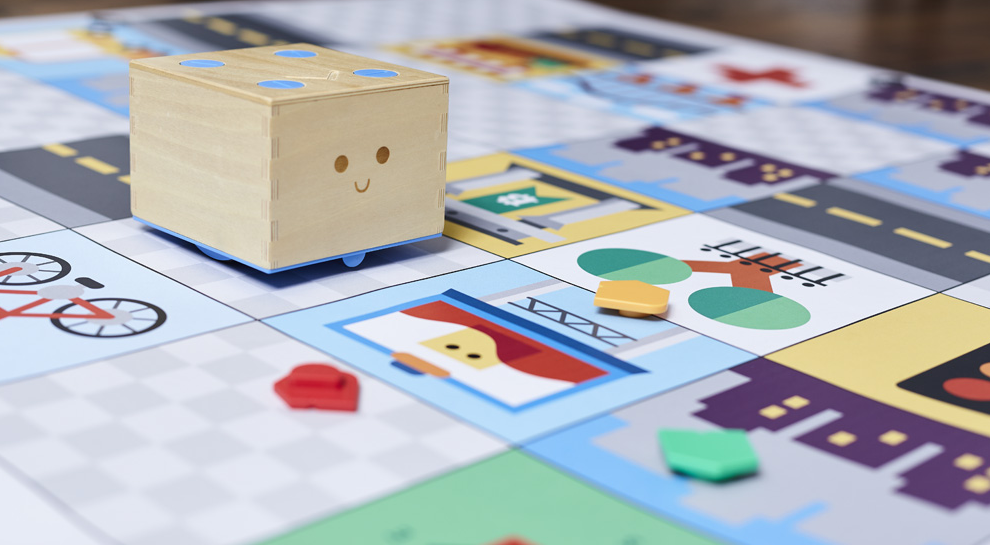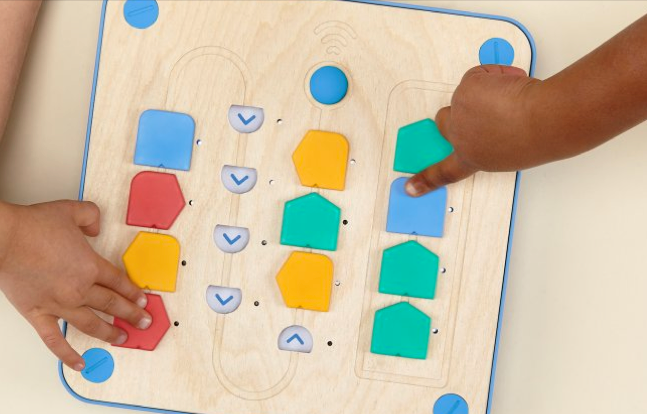| The Cubetto is a wooden robot that pairs with a control board and can be programmed by preschoolers. 1. Cubetto teaches kids as young as three years old to code. |
Getting Started
The Cubetto doesn’t require any devices, Internet connection, or software and is just about ready to go right out of the box. The only things you need are a screwdriver and batteries: Three AA’s for the robot and also three AA’s for the board. These batteries should last for up to five hours of continuous play, so make sure to power them off when done.
Once you’ve got the batteries in, you can turn the robot and the board on by sliding the switches underneath both devices. The batteries are working if the LED’s turn on underneath the robot and on the front of the board. The robot and the board should then begin to automatically pair. Then, you don’t have to do anything except make sure they remain within about 30 feet of each other.

Creating a Sequence and Function
There are certainly plenty of Cubetto lesson plans educators could use in a preschool classroom and the robot itself helps make it very easy. Almost all of them drive purposeful experiences and help students use the blocks to explore computational thinking. When a student inserts any of Cubetto’s blocks into the board, the LED below the block will light up. The different colors and shapes of the blocks each represent a different action. The green block tells the robot to move 15 centimeters forward. The yellow block tells it to turn left 90 degrees counterclockwise and the red block tells it to turn right 90 degrees clockwise.
Finally, the blue block (the function block) is the coolest one of the group. When the robot detects this block, it executes the combination of commands from the function line on the board (left, forward, right, for example). The newer Cubetto blocks also include a light yellow block, which represents negation (performing the opposite action of the following block) and the black block, which represents a random action and results in the robot performing a random move.
When the blue button on the board is pressed, the Cubetto reads and complete the program. If students change the blocks while the Cubetto is running a program, it won't be affected and will complete it. While an action is being executed, the corresponding LED will flash as well as make a sound. The function section of the board allows for students to “pack” more instructions into one block. They can create a sequence of blocks on the bottom line of the board that they can then repeat whenever they place a blue block in the main sequence.

The Cubetto Robot in the Classroom
Perhaps the best feature of the Cubetto (along with the fact that it can be used by preschool-aged children) is that they don’t even need to know how to code in order to use it! It introduces coding concepts, such as algorithms and functions, while kids actively engage with programming. It also encourages students to create programs using tangible instructional blocks. Plus, the robot itself is very sturdy with its wooden surface that is not only durable but also loved by children.
One of the most relevant features of the Cubetto robot is certainly its ability to help young children understand logic. Using the Cubetto programming blocks, they see how certain elements of programs come together to create the desired result. Of the various Cubetto accessories, the Logic Blocks provide educators with some additional coding blocks to use with the robot. In this pack, specifically, there are four negotiation blocks, four random blocks, and four function blocks. All of them fit in the control board, allowing children to continue building those developmental skills.
There is one main Cubetto robot kit available on our store: The Cubetto Playset. Besides that, we carry all of the popular Cubetto accessories. These include the extra direction blocks and logic blocks as well as the Coloring Pack and Logic Pack. Finally, we also stock a few of the themed add-ons so students can combine robotics and coding with other academic areas, like social studies—even at a young age.
Teachers can also use multiple Cubetto’s in the classroom and the board will just connect to the nearest robot. It's great for individual use or in small teams to encourage collaboration and group problem solving. The Primo team, the creators of the Cubetto line, have also conducted case studies on the use of Cubetto by students with learning differences. They've discovered that the robot's simplicity is one of the top reasons it's effective in these types of settings. Lastly, we encourage educators to take a look at the teacher’s guide for Cubetto, including background, activities, and other resources.
As always, we'll try to get educators the best Cubetto robot price possible. To purchase a Cubetto robot or any of the accessory packs, click below or visit our store. If you have any questions regarding the Cubetto robot, feel free to get in touch with us. Follow us on Twitter and Instagram for more EdTech Tips & Tricks!







